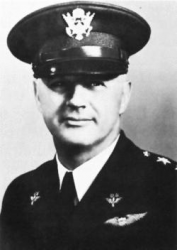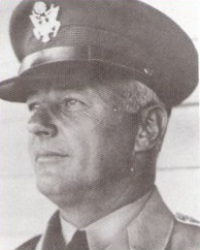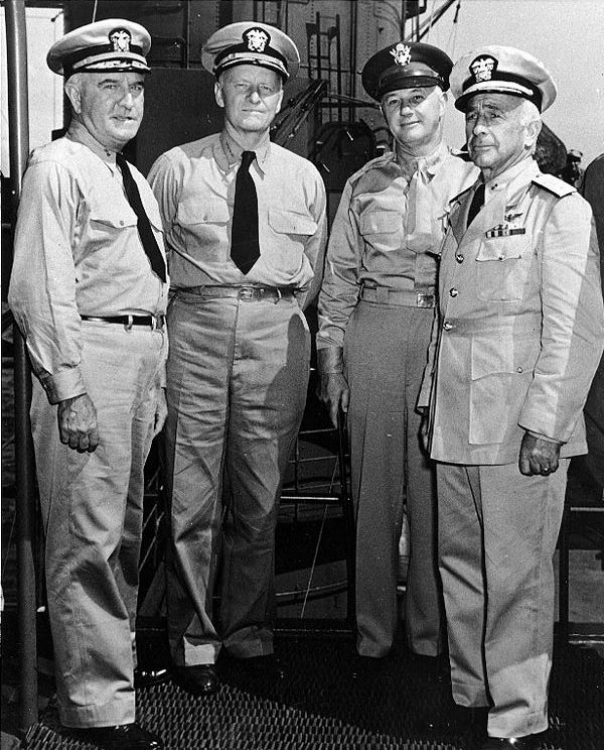
 |
|
|
||
|
Delos Carleton Emmons |
||||
|
Engagements: • World War I (1914 - 1918)• World War II (1941 - 1945) |
||||
| Biography: | ||||
|
Delos Carleton Emmons Delos Carleton Emmons was born on 17 January 1889 in Huntington, WV, the son of Carleton Delos and Minnie S. Gibson Emmons. Military Career Emmons graduated from the U.S. Military Academy in June 1909 and was commissioned as a Second Lieutenant of Infantry. He was assigned as Commanding Officer, Company B, 30th Infantry, Presidio of San Francisco, CA, and then moved to Fort Gibbon, AK, with the unit. He was then assigned to Plattsburg Barracks, NY, where the Civilian Military Training Camp was located. [The brainchild of General Leonard Wood, it was the forerunner of today's Reserve Officers' Training Corps (ROTC) program.] In March 1939, Emmons received his second star as a Major General when he was appointed Commanding General of General Headquarters (GHQ) Air Force, Langley Field, VA, succeeding Major General Frank Andrews, who had just completed four years in the position. While at GHQ, Emmons commanded a flight of seven B-17 bombers on a goodwill mission from Langley Field to Rio de Janeiro, Brazil. After the fall of France, the Americans and British increased their military cooperation and Emmons, Rear Admiral Robert L. Ghormley, and Brigadier General George V. Strong, were assigned temporary duty as Military Observers and sent to London on 6 August 1940. In November 1940, he was promoted to Lieutenant General when Army General Headquarters was activated, in order to make him equal in grade to other GHQ subordinate commanders. He retained his command when GHQ Air Force was renamed Air Force Combat Command in June 1941 and made a part of the new U.S. Army Air Forces. However, this caused command difficulties since he was now superior in rank to his boss, Major General Henry "Hap" Arnold, the new Chief of the Army Air Forces. Ten days after the attack on Pearl Harbor, Emmons returned to Hawaii as Commanding General of the Hawaiian Department. Emmons requested Army Air Force Headquarters to send additional planes and he received them as rapidly as possible. Emmons built up the forces in Hawaii, anticipating a battle at Midway. [Emmons succeeded Lieutenant General Walter C. Short who, on 17 December 1941, was removed from command of Pearl Harbor as a result of the attack. Short was ordered back to Washington by Army Chief of Staff George C. Marshall. He was reduced from the temporary rank of Lieutenant General to his permanent rank of Major General, since temporary ranks are contingent on the command.] Returning to the U.S. mainland in June 1943, Emmons was assigned three months later as Commanding General of the Western Defense Command, Presidio of San Francisco, CA. He was then Commanding General of the Alaskan Department, Fort Richardson, AK, from June 1944 to June 1946. He became Commandant of the Armed Forces Staff College at Norfolk, VA, in August 1946, and remained in that position until he retired of an 'in line of duty' disability on 30 June 1948. Medals, Awards and Badges Distinguished Service Medal with 2 Bronze Oak Leaf Clusters Side Story # 1: Internment of Japanese-Americans Unlike their counterparts in California, Hawaii's public officials urged restraint and reason. Congressional delegate Sam King advised the military that nothing should be done beyond apprehending known spies. In contrast to General DeWitt, as the military governor of Hawaii, Lieutenant General Delos Emmons opposed Washington's efforts to evacuate and intern Japanese Americans in Hawaii. Emmons believed that the Constitution guaranteed the right of due process of law to every person, and was determined to base his policies and actions on this principle. Side Story # 2: Japanese-Americans in the Military Within weeks of the attack on Pearl Harbor, the Military Governor of Hawaii, Lieutenant General Emmons, discharged all Japanese from the Hawaiian Territorial Guard and the 298th and 299th Regiments of the National Guard of Hawaii. The young men who had the most to prove and the greatest reason to fight for their homeland were denied the chance to serve. But they would not be denied. The discharged Japanese veterans appealed to Emmons to allow them to support the war effort of their Nation . . . in any capacity. Their persistence paid off, and Emmons consented to give some of them an opportunity to function in "support" roles. Although the support roles mostly consisted of menial tasks, the young Nisei performed them with dedication and resolve. Emmons noted their patriotism and endurance, and saw beyond the hysteria and paranoia around him. He recommended to the War Department that these pre-Pearl Harbor veterans be formed into a special unit, shipped to the mainland, and trained for combat. On 26 May 1942, Army Chief of Staff General George C. Marshall responded, establishing the Hawaiian Provisional Battalion, returning to military service many young Nisei (second generation Japanese) who had been summarily discharged after the 7 December attack. From these, 1,300 were selected to ship out on 5 June under the guidance of 29 white officers under the command of Lieutenant Colonel Farrant Turner. By mid-June the unit was attached to the 2nd Army at Camp McCoy, WI, and beginning six months of basic training. The Hawaiian Provisional Battalion was re-designated the 100th Infantry Battalion. Its motto: "Remember Pearl Harbor!" In January 1943, General Marshall approved the formation of the group for combat and in February the 442nd Regimental Combat Team was activated under the command of Colonel Charles W. Pence. Nisei also served prominently in the 100th Infantry Battalion. Both groups fought in Europe and in June 1944 they joined ranks in Italy, the 100th becoming the first battalion of the 442nd Regimental Combat Team; because of its outstanding record, the 100th was allowed to keep its original designation. These two groups became the most decorated units of their size in U.S. Army history, winning eight Presidential Unit Citations and over 18,000 individual decorations for bravery. Death and Burial Lieutenant General Delos Carleton Emmons, a man that Time Magazine called "a hard-riding perfectionist, tough as parachute silk," passed away on 3 October 1965, at age 76. He is buried at Arlington National Cemetery in Arlington, VA. |
||||
| Honoree ID: 3275 | Created by: MHOH | |||
Ribbons
Medals
Badges
Honoree Photos
 |  |  |
 |  |
 |


